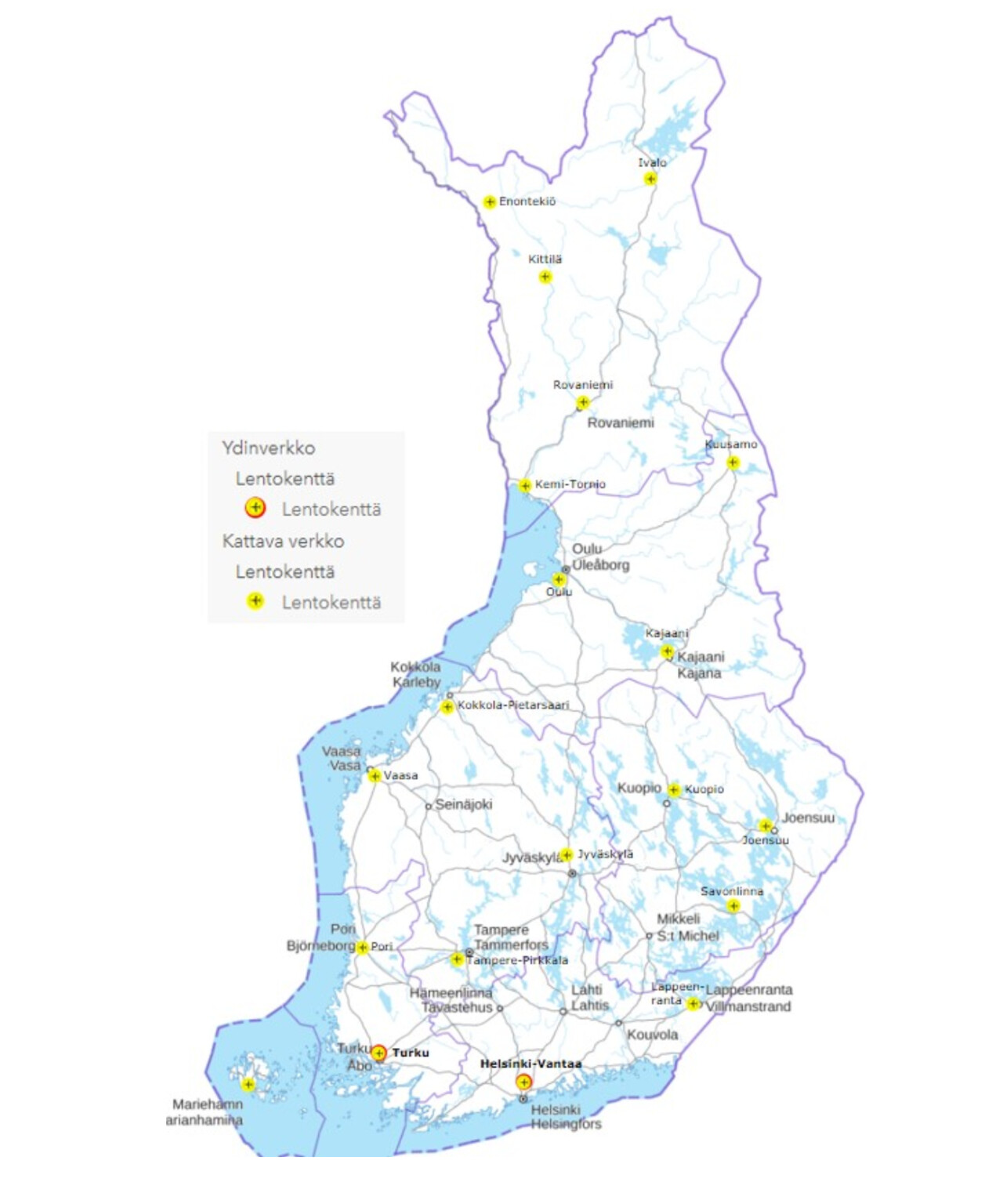This situational picture provides information about the demand and capacity of Finland’s airports and the fulfilment of TEN-T criteria for airports. The situational picture of airports is primarily updated once a year. The information is produced by the Finnish Transport and Communications Agency Traficom. The information is part of the strategic situational picture of the Finnish transport system.
Airport network, demand characteristics and capacity
There are 22 airports in Finland, 20 of which are owned by Finavia, and the airports in Lappeenranta and Enontekiö are owned by the municipality. Mikkeli and Seinäjoki also have airports, but these airports do not have regular scheduled service. In Finland, some airports are exceptionally also used by the armed forces. Of the airports owned by Finavia, Utti and Halli are only used for military and recreational purposes.
Helsinki Airport
Helsinki Airport is the most important airport in Finland and a key node for international accessibility. It is the primary investment project of Finavia.
Growing airports (Oulu, Rovaniemi, Kittilä, Ivalo, Kuusamo)
Air transport in Oulu is increasing in the long term, because the distance from Oulu to Helsinki is long and ground transport cannot compete with air transport. The increase is also affected by the vitality of the economic development in the region. Tourism is very important to Lapland, and the number of passengers has increased significantly in the past few years at the largest airports. Seasonal peak times at airports in Lapland require sufficient infrastructure capacity in the peak seasons. Finavia has made sizable investments in airports in Lapland in 2018–2020.
Airports with unchanged demand (Turku, Vaasa, Tampere, Kuopio)
These airports are typically regional centres where economic development affects demand, as the share of business travel is significant in the number of passengers. Growth in air traffic is, however, curbed by the continuous improvement in the competitiveness of other modes of transport, especially as the distances are relatively short.
Small airports (other)
These airports have the least passengers. The negative development of the economy and population and the aging of the population in these areas is decreasing demand for air transport. The number of passengers in small airports in regressive areas may not necessarily increase even if the local economy picks up.
SITUATIONAL PICTURE OF AIRPORT CAPACITIES
Helsinki Airport | Investments currently being planned will enable growth to 30 million passengers per year. |
Airports in Oulu and Lapland | The capacity of the Oulu airport is estimated to suffice for several years according to the growth prognosis. Finavia’s development programme for airports in Lapland was completed in 2020. Following investment, the airport capacity in Lapland increased significantly and will suffice for the estimated moderate growth from the current 1.5 million passengers to 2.0 million passengers, given that the traffic structure remains the same. |
Medium-sized airports | The capacity is sufficient in terms of demand. Investments have been made to Tampere Airport in recent years after demand increased, e.g. after pilot training increased in the airport. |
Additional notes on the capacity situation:
- The development needs of airports may be significantly affected by changes in the structure of industry in an individual town (new investment / closures).
- Emergency transportation mainly requires helicopter operations, other air traffic is needed only occasionally.
- In Finland, some airports are exceptionally also used by the armed forces.
Impact of COVID-19 on airports in 2020
In 2020, the combined number of passengers in airports declined by approximately 75%, i.e. approximately by 20 million passengers compared to 2019.
- A total of five million passengers travelled from Helsinki Airport (21.9 million in 2019), four million of which were international passengers.
A total of 14 airports were closed at some point in 2020 and a limited number of operations were available (13 Finavia airports + Lappeenranta). Some runways have had to have been closed for fixed periods after demand collapsed, including at Helsinki Airport.
- Traffic from Helsinki to five airports, Joensuu, Kajaani, Kemi-Tornio, Jyväskylä and Kokkola-Pietarsaari, was suspended at first, but started up again for the winter season with a skeletal schedule. In 2021, the government purchased services on these routes.
Finavia has utilised the low numbers of passengers to decrease traffic during the pandemic and continue its expansion and repair projects, and brought them forward in some cases.
- The development programme for airports in Lapland was completed in 2020.
- The renovation of the Helsinki Airport aprons was completed by the end of 2020. The expansion and changes to terminal 2 are progressing faster than anticipated.
- In spring 2021, Finavia renewed the tarmac at Mariehamn Airport (the airport was closed 16 May–3 July 2021).
- Finavia achieved its carbon-neutrality goal in accordance with its climate programme in all its airports in 2019.

Airport accessibility
- Barrier-free access to regions can be improved through transport chains to airports, which would create new connections.
- In order to develop genuine, attractive options for travellers, transport chains should be comprehensively linked with taxi, bus and railway journeys and other mobility services in addition to flights. Efficient transport chains reduce emissions per passenger.
- Key challenges include airport accessibility on public transport as well as the development of travel information concerning transport chains and mobility services.
- The ability to buy a single ticket for the entire journey, which eliminates the passenger’s risk of missing a connection, makes a transport chain extremely competitive.
- Development efforts over the long term could focus on improving airport accessibility through railway connections.
- Long-distance passenger service and commuter rail service connections.